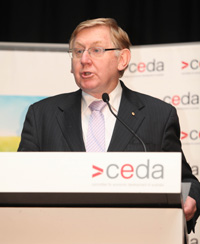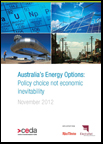Explore our Progress 2050 Goal Tracker
31/10/2012
 |
||||
CEDA's Australia's Energy Options report launch
Minister Ferguson launched CEDA's final publication in Australia's Energy Options Series: Policy choice not economic inevitability.
Minister Ferguson's speech below was sourced from http://minister.ret.gov.au
14 November 2012
Four Seasons Hotel, Sydney
* Check against delivery
Introduction
Ladies and Gentlemen, it is a pleasure to be with you here today, for what will be my second CEDA event in as many weeks.
Last Thursday, I was pleased to launch the Australian Government's Energy White Paper.
Today, I will be launching CEDA's final report from their 'Australia's Energy Options' project.
Both papers recognise the emerging challenges in Australia's energy sector, and present a long-term vision for strengthening our energy economy.
The parallels between the Energy White Paper and this report are striking.
CEDA's report presents a number of recommendations across four key areas:
Energy Markets;
Unconventional gas;
Renewable and energy efficiency; and
Nuclear.
It is these key areas that I will focus on today.
Energy Markets
As we all recognise high electricity prices are of concern to households and businesses around Australia.
Addressing this issue was a core theme of the Energy White Paper and I am not surprised that CEDA's report provides a number of recommendations in this regard.
They include options around government ownership of network assets, amendments to the regulatory framework and improving consumer participation.
CEDA's recommendations broadly align with the significant body of work the Government currently has underway through the Standing Council on Energy and resources, or SCER, which I chair.
Together with my fellow Energy Ministers, we are working to ensure the Australia's energy markets are operating in the best interests of consumers.
In addition, the Prime Minister has sought a firm commitment from the states and territories to a number of outstanding actions by the end of the year.
As identified by CEDA, and in line with the Energy White Paper, our energy markets need to evolve to better serve consumers.
A key aspect of this reform package will be supporting the states and territories should they move towards greater competition in retail pricing.
Greater competition will drive innovation as retailers compete to offer consumers new services and products better suited to their needs.
It will also give consumers greater choice about what tariffs they sign up to and options to help minimise their energy costs.
But where there is also greater competition the Government also recognises strong protections must be in place to protect vulnerable customers.
That is why the Australian Government encourages state and territory governments to fulfil their commitments to adopt the National Energy Customer Framework.
If we are to provide consumers with more choice then we also need to promote better information through tools, like smart meters.
The Energy White Paper highlights the benefits of smart meters as we move to a more intelligent and responsive energy system.
Smart meters have the potential to play a central role in helping consumers track their energy use when connected to web-portals and in-home displays.
They will be essential if we are to move to cost reflective pricing and curb rising peak demand, reducing the need for costly investment in our poles and wires.
Contrary to some media reporting the Australian Government's Energy White Paper does not propose a national roll-out of smart meters, but rather supports a market-driven roll out of smart meters.
That is where energy retailers or distributors could seek to offer smart meters as part of a retail package to consumers.
Providing consumers with choice, such as the option to move to time-of-use pricing tariff is the best way to ensure customers make decisions that are right for them.
These are some of the key reforms the Australian Government will be seeking to progress with states and territories at SCER later this month and then at COAG in December.
Unconventional gas
This brings me to the second of CEDA's key issues that also aligns with the Government's current work program through SCER - the burgeoning unconventional gas sector.
Relatively new forms of onshore resources such as coal seam, shale and tight gas will play an increasingly prominent role in supplying global gas markets.
This recent change was highlighted by the International Energy Agency's annual World Energy Outlook released in London two days ago.
The IEA finds that oil and gas will meet an increasing proportion of global energy demand, driven by upstream technologies that are unlocking light tight oil and shale gas resources.
Nowhere is this more evident than in the United States, where the IEA predicts that the US will overtake Saudi Arabia as the world's largest oil producer by 2020.
A finding many would find hard to believe less than ten years ago.
Australia too can benefit from recent developments that allow us to unlock our unconventional gas resources.
Indeed, our reserves are so significant they may one day exceed our conventional offshore gas supplies.
But where there are similarities with the United States, we must also recognise the differences in geology, product composition, and of course location.
Australia is ideally positioned on the door step of Asia and has a comparative advantage in terms of meeting the demands of the world's key export market.
But there are a number of regulatory challenges we need to overcome in order to meet global energy demands and maintain our competitive edge.
The projected tightening of the supply and demand balance in the east-coast reinforces the need to ensure robust regulatory frameworks provide for the timely supply of gas to market.
To date, CSG has been markedly impressive and now accounts for about 35 per cent of eastern states domestic gas production.
Australia produced about 6.2 billion cubic metres of CSG in 2010-11, with 97 per cent coming from Queensland.
Its development brings significant benefits in terms of wealth creation, employment and energy security.
It will also generate considerable export earnings once the three CSG-to-liquefied natural gas projects in Queensland's Gladstone region are up and running.
But we cannot take these types of benefits for granted.
The CSG industry has a particularly pressing need to maintain a social licence to operate, highlighted in CEDA's report.
This arises from community concerns around the possible impacts of new operations on land access, water resources and agricultural production.
In response, the Australian and state and territory governments have been actively working to build harmonised regulatory regimes and ensure objective scientific evidence backs up all decision-making in the sector.
SCER is once again coordinating efforts in this area.
In December last year, it agreed to develop a nationally harmonised regulatory framework for coal seam gas to address key community concerns.
This framework develops leading practices in the key areas of well integrity, the management and monitoring of water, hydraulic fracturing, and chemical use.
Again this is an aim we have in common with the recommendations in CEDA's report - to establish clear and well resourced processes and adopt best practice management.
We have maintained our focus on these areas through the formation of an Independent Expert Scientific Committee supported by $150 million in research funding, to provide advice on the nexus between CSG developments and water.
Geoscience Australia
The key to maintaining Australia's impressive pipeline of projects for all energy types is to constantly improve our knowledge of the nation's resource base.
This is the role of Geoscience Australia.
GA is highly regarded by industry and state governments for its professionalism and expertise in this field.
Its work after all is the basis for so many of the large resource projects we have underway in Australia today.
That is why it so important we see the work of GA continue.
Today I am pleased to announce that the Australian Government has committed to locking-in $34 million in 2013-14 and $40 million every year thereafter to fund a range of on-going activities at GA.
This includes:
a $26 million per annum commitment to GA's pre-competitive data work to improve its knowledge of Australia's resource base and open up opportunities for new resource projects.
a further $5 million increasing to $8 million in 2014-15 for groundwater modelling capabilities to better assess the long term health of the Murray-Darling Basin and other regions.
and lastly, $3 million increasing to $6 million in 2014-15 for natural disaster planning and response including the Australian Tsunami Warning System.
This equates to total funding of $114 million to GA over the current forward estimates.
This work is fundamental to ensuring scientific and evidence-based decision making underpins our resource development.
This work will also contribute to the regular release of acreage for exploration, which the Australian Government continues to work cooperatively with the states and territories, by developing a five-year Acreage Release Strategy.
Today I also announce that the Australian Government will introduce cash bidding for offshore petroleum acreage release.
This will apply only to mature areas, or those known to contain petroleum accumulations.
This will prevent over-exploration in areas where none or little may be required and ensures the release of these areas is equitable, economic and efficient.
The Government recognises that in a global context, most of Australia's petroleum basins have been lightly explored.
Successful bidders will have the right to develop economic discoveries by applying for a production licence, and to retain uneconomic discoveries through retention leases.
Permits will be awarded subject to current terms regarding relinquishment, data submission and management.
The Government will consult with industry on the development of the detailed application of cash bidding to ensure confidence in the arrangements.
Revenue raised through the introduction of cash bidding for mature areas will be directly returned to the budget for the benefit of all Australians.
Importantly, this prospectus will encourage future investment in the Australian oil and gas industry.
Clean energy
While both traditional and unconventional fossil fuels will remain part of Australia's energy mix into the future, the rise of clean and renewable supplies is another marked trend within the energy sector.
The announcement of the Clean Energy Future package last year, including the establishment of a carbon price, was a milestone in Australia's commitment to address climate change.
The Energy White Paper builds on this achievement, but applies itself more broadly to ensuring the energy market delivers secure, reliable, clean and competitively priced energy to consumers.
In this respect, the Energy White Paper and CEDA remain in lock-step on the increased deployment of clean energy technologies.
We agree that low emissions technologies have a role to play in meeting growing energy demand while reducing greenhouse gas emissions, but it is important that the market drive this change.
This is because the Australian Government, like CEDA, wants to achieve emissions reductions at the lowest possible costs to ensure that renewable energy policies are socially sustainable over the longer term.
The Australian Government also supports CEDA's call for the greater uptake of energy efficiency measures.
The success of the Australian Government's Energy Efficiency Opportunities Program is a stand out example of the benefits of energy efficiency.
Companies participating in EEO Program have already adopted savings that represent net financial benefits of $810 million per annum.
That is, rather than imposing a huge cost on business, the EEO program has helped businesses save money through energy efficiency.
The EEO program will also achieve abatement equivalent to one and a half per cent of Australia's total greenhouse gas emissions.
Few abatement programs can claim to reduce emissions while reducing costs.
And the Australian Government is looking to further help businesses participating in the EEO program by streamlining the reporting requirements.
In addition to supporting energy efficiency, the Government is committed to funding the development of less mature clean energy technologies.
Through more than $17 billion in assistance, we are positioning Australia as a world leader in the research and development of new renewable and low emission technologies.
The formation of the new Australian Renewable Energy Agency has been central to these efforts.
Earlier this week ARENA released its inaugural funding strategy which paves the way for $2.2 billion in uncommitted funding to improve the competiveness of Australia's renewable energy technologies.
One of the key challenges for ARENA and the Government generally will be to address the obstacles facing first-of-their-kind commercial demonstration projects for solar, geothermal and other technologies.
We will need to take into account the lessons we have learnt to date - and there will undoubtedly be more along the way - to make sure that future support is structured effectively and delivers the greatest possible benefit to Australia.
Nuclear
Turning now to the last of the issues highlighted in the CEDA report - nuclear.
I acknowledge CEDA's support for nuclear energy.
However as the Energy White Paper makes clear, nuclear power is not needed as part of Australia's energy mix, given our country's abundance and diversity of low-cost and reliable energy sources, both fossil fuel and renewable.
Indeed nuclear has never been needed because it has not been economically competitive nor has it had the required community support.
But the community will continue to have these debates, just like we have had a debate over the previous decades about uranium mining.
The Australian Government's responsibility is to test all forms of clean energy and if at some point in the future we don't get the breakthrough on baseload clean energy - Australia will need to think seriously about considering nuclear.
Conclusion
As CEDA's final report recognises managing Australia's energy transformation into the future will not be easy.
We have a growing population, a growing economy and a growing need to reduce our emissions at the same time.
Thankfully, we also have a growing range of energy options such as renewables and unconventional gas available to us.
And the market based policy settings of the Energy White Paper are designed to help Australia maximise the benefits of our natural resource endowment.
I'd like to thank CEDA again for their ongoing commitment to a high quality policy debate here in Australia.
Together our two documents help lay the foundations-it's now time to begin building consensus.
Thank you.
This speech appears on http://minister.ret.gov.au.


